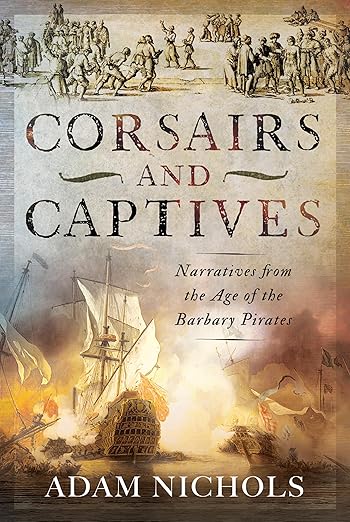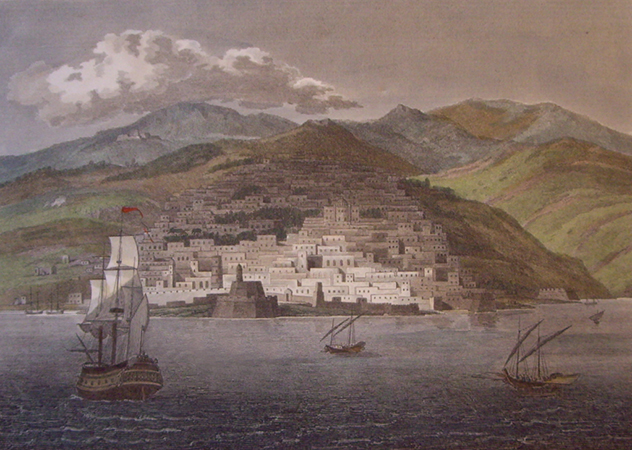This week we return to the series of posts about Algiers describing what the experience would have been like for European captives who were brought into that city.
The last post in this series began the story of Jón Vestman, a teenager who had been captured by corsairs from Algiers on the island of Heimaey, off the south coast of Iceland. Jón, remember, converted to Islam and began a career as a corsair.
There are, however, different versions of Jón’s story told in the Icelandic sources. The one recounted in the last blog post about him wasn’t really very credible. This week, we take up an alternate—and more credible—narrative.
This story has Jón returning to Algiers in the fall, at the end of a corsair season, as part of a flotilla of twenty ships. Once again, the men around him were drinking. In their drunken state, some of the renegades began talking about how they could overpower the Turkish crew and escape with the ships.
Jón recognized this as a drunken fantasy and wanted no part of it. He also realized that it would bring big trouble down on everybody when, inevitably, one of the drunkards blabbed to the wrong person. So Jón slipped away.
This proved to be a sensible decision, for the drunken renegades were rounded up and executed the next day. Jón fled from Algiers and travelled eastwards to Palestine, across the Jordan River, and beyond. He remained there, securely in hiding, for two years until he managed to negotiate a safe return.
Clearly, he still had powerful patrons in Algiers.
After this, Jón returned to corsairing, successfully captaining a ship for several years and becoming a well respected—and well-to-do—figure in Algiers.
It didn’t last, though.
One day, a fleet of ten corsair ships Jón was part of encountered some galleys from Malta—home base of the Knights Hospitallers. Maltese galleys were large, fearsome ships. The corsair fleet was sunk, and the crews killed or captured.
Jón survived. He was fished out of the sea and, along with a number of other corsairs, ended up in the dungeons of Valletta (the port city on the island of Malta that the Knights Hospitaller used as their headquarters). Jón and the others taken with him were sentenced to be burned at the stake.
At the last minute, though, a young Spanish hidalgo (nobleman) who was visiting Malta ransomed Jón. It is not clear why he should have done this, or how he might have convinced the Knights to release Jón, a renegade corsair captain. He managed it somehow, though, and took Jón with him when he returned to Spain.
There, Jón impressed everybody. Jón was, remember, a well-educated and intelligent young man. While in Algiers, he had learned how to play chess (Muslim Arabs brought chess with them when they invaded North Africa). Not only had he learned the game; he had learned it so well that the Spaniards considered him a chess master. This reflected well on the young hidalgo who had brought him out of Malta, and he happily paraded Jón through the elite social circles in which he moved.
Jón had apparently learned other things in Algiers other than chess, though, including how to make maps and charts—a rare and valuable skill in those days. One morning the young hidalgo caught Jón measuring the geometry of the place in which they were staying and drawing a map of it. He grew suspicious of Jón’s motives for doing this, and the “honeymoon” period between them ended. Once again, Jón saw the danger inherent in the situation, and he slipped quietly away—as he had done back in Algiers.
This time, he did not flee to Palestine… but to Marseilles.
He chose Marseilles because his sister, Margrét, lived there. Margrét had been captured with Jón. A man named von Iberscheel had bought her at the Badestan, and she had two children with him. After some years residence in Algiers, Margrét and her children moved to Marseilles. It’s not clear exactly when, how, or why they left Algiers, nor if von Iberscheel accompanied them.
It’s difficult to pin down exactly when Jón arrived in Marseilles, but it was likely sometime towards the end of 1644 or beginning of 1645—almost twenty years since the two siblings had last seen each other. They must have had a lot to catch up on.
If Jón had expected to meet von Iberscheel himself in Marseilles, he was disappointed.
Von Iberscheel had departed for the Netherlands—to marry a Dutch woman. It is not clear whether he made any sort of provision for Margrét and the children or if he had simply abandoned them. Perhaps it was not clear to Jón, either, for he moved on from Marseilles to the Netherlands, in search of von Iberscheel.
By this point in his life, Jón was not a good person to have as an enemy. He was a seasoned, successful corsair captain, a ruthlessly determined man accustomed to dangerous situations and violent conflict. According to the Icelandic sources, Jón and von Iberscheel came to “an agreement” regarding Margrét—an agreement, perhaps, that Jón forced upon von Iberscheel. Whatever the case, there are no further details regarding Margrét and her children, and the stories told about Jón move on, leaving his sister’s fate unresolved.
From the Netherlands, Jón went to Denmark, arriving there sometime in late 1645 or early 1646. He soon became celebrated as a sort of national prodigal son, known as Jón Vestmann because of his origins (“Vestmann” being a version of “Westman,” as in Westman Islands, the islands of which Heiney is a part).
_____
For the continuation of Jón’s story, see the next post here in this blog.

Corsairs and Captives
Narratives from the Age of the Barbary Pirates
View Amazon listing
The Travels of Reverend Ólafur Egilsson
The story of the Barbary corsair raid on Iceland in 1627
View Amazon listing